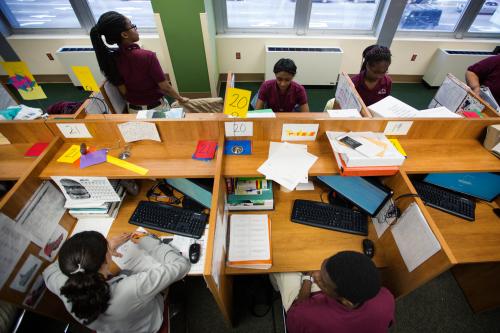As charter school enrollments grow, are school districts so weakened by financial losses that teaching and learning must suffer? Or does competition spur traditional public schools and districts to improve—for the benefit of all?
There are bodies of research and policy advocacy on both questions, but the results are difficult to reconcile.
Studies focusing on charters’ effects on district finances mostly find harm, and infer that school quality must be suffering. Studies focusing on charters’ effects on overall instructional quality often find no effects but find positive effects much more often than harm to students.
Is somebody wrong here? Does charter growth wreck district schools, or does competition lift all boats?
Some facts are generally accepted: When students leave a district for any reason (moving away, enrolling in charter or private schools) the district no longer has to pay to educate them, but some costs remain.
But there is serious disagreement about the consequences. The “inevitable harm” narrative has become a rallying cry in teachers union strikes from California to West Virginia. Los Angeles union leaders sought and won state support for anti-charter caps and regulations.
Studies on district finances focus on “sticky” costs that can’t be adjusted quickly as district enrollment falls—debts, pension obligations, and administrative costs, for example. These are essentially fixed costs in a year when enrollment declines. Other cost drivers (administrative staffing policies, schools too small to support their overhead, etc.) are within the district’s power to fix.
Whatever the remaining costs, they must be paid from the income generated by a smaller number of students, so more of the district’s available funding goes to overhead. Assumptions about what costs are fixed and where cuts can be made are crucial. Studies that take great care in testing assumptions and offsetting savings against costs inevitably find expenses left behind in the first year after district enrollment falls, but vary on how long those persist.
Careful studies estimate that, in the year after a student transfers to a charter school, anywhere from $1,500 to $3,500 of fixed costs must be paid from a shrinking district budget. Some reporting higher numbers assume districts can do little to adjust spending.
Studies of the second question on the effects of charter school enrollment on district school quality look at different evidence: test scores and other student outcomes like attendance and persistence. Though they do not consistently find benefits to students in district schools, they rarely find the harm predicted on the basis of districts’ overall funding and costs.
These studies have appeared from 2005 to the present. Recent ones of New York City and Massachusetts have some of the strongest positive results. New studies of Chicago and Denver—though not focused directly on the effects of charter competition—show improvements in district schools even as charter enrollment grows and some charter schools stand out as high performers. A recent study of schools in Washington, D.C., shows neither harm nor benefit to students in district-run public schools, except for benefits to students whose schools are near high-performing charter schools.
Recent studies also provide some evidence about whether and how district schools improve in the face of charter competition. For example, a 2018 study of New York City shows that district schools increase funding in affected schools. A 2018 study of Massachusetts suggests short-term subsidies to districts can soften the effects of enrollment loss to charter schools. Studies of Denver and Chicago show that enhanced school freedom of action is a factor in the improvement of district schools in a charter-rich environment.
Earlier studies were possibly less positive because they relied on data more than a decade old, and before districts (Chicago and Denver, for example) learned how to improve their schools while charters grew. This is credible in light of evidence that schools facing competition can steadily improve over several years.
RAND’s 2009 study of charter schools in eight cities found few effects in either direction, except for some negative effects in Texas. Two early statewide studies of Ohio and Michigan also documented slight declines in public school test scores. Mixed results are also common in early studies—for example, positive effects on reading scores but negative effects on mathematics, or vice versa. One early study of an unidentified city found negative effects on elementary school students but positive ones for high schoolers.
How can it be that some studies find enrollment shifts to charter schools harm district finances, while others seldom find harm and often find benefits to students? The studies look at different outcomes, so it is possible that districts struggle financially but succeed in insulating students from harm.
This is consistent with new reports on California. One, from the Center on Reinventing Public Education, which I founded, finds no evidence that charter school growth increases the chances school districts will be flagged by the state for fiscal distress. The other, from a University of Southern California researcher, finds districts facing charter school competition tend to have lower fund balances, but do not show higher levels of debt or other, more severe signs of financial stress.
None of these studies examine educational and financial effects of charter schools in the same cities. To sort out financial and achievement effects, we need coordinated studies in particular cities, analyzing the effects of charter growth on district finances and tracing these through school funding and instructional practices to effects on students.
The question of effects of charter growth on district schools and students is important enough to warrant thorough and objective study: a sample of districts impacted by charter schools with careful review of financial challenges, district responses, consequences for school operations, and student results.
But until such studies are done, people with different perspectives will remain in well-established warring camps. Policymakers and voters can’t know whether the competing findings on financial and educational results are either:
1. Both true: Districts are stressed financially by the shifts of resources they must make in order to compete with charter schools, but not helpless. Districts can feel budgetary pain even while their schools are protected and enhanced; or
2. Not both true in all situations: For example, in localities that are above some threshold of debt, fixed costs, charter growth rate, or political stalemate that make it impossible for them to sustain school quality.
The facts can be hard. There is no need to settle for incomplete or cherry-picked evidence. At a time when people who care about children abhor false claims and biased arguments, foundations or government could step up to sponsor the needed research. Until then, voters and policymakers should be skeptical about claims that charter school growth harms district schools.
The Brookings Institution is committed to quality, independence, and impact.
We are supported by a diverse array of funders. In line with our values and policies, each Brookings publication represents the sole views of its author(s).








Commentary
Charter schools: Good or bad for students in district schools?
June 7, 2019